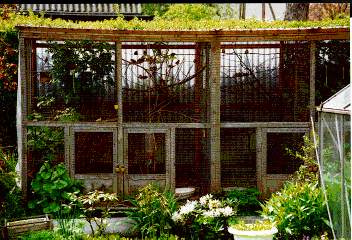
This is a short introduction to the basic care of Zebra Finches. Find out what food they eat and what type of cage to get. There is also a short introduction to breeding.
Housing
Zebra finches can be kept in cages or aviaries, indoors or outdoors. Since zebra finches are very hardy, they are able to tolerate many different environments without any problems. However, you should avoid placing them where it may rain on them. You should also avoid changing the environment too rapidly, since the birds
will need to acclimatise to the new environment. Generally, healthy acclimatised zebra finches will feel quite all right with temperatures between 5° Celsius and 30° Celsius. However, when breeding 15° Celsius should be the minimum temperature. (recommended temperatures may vary from region to region depending on humidity, etc.).
You might find it interesting to see an example of how you could keep your birds. This is actually how I used to keep my birds until a few years ago.
Cages or Aviaries?
So where do I keep my birds, I hear you ask. Well, basically you have two choices: Either in a cage or in an aviary. If you just have one or two pairs, then you might want to keep the birds indoors. However, you should be aware that this will cause some inconveniences, as the birds can be quite messy. Indoors you will probably use a cage to keep your birds in. Many people have a shed in their back yard for those birds that are in cages. If you would rather keep your birds outdoors, then you would probably need an aviary.
Whether you chose an aviary or a cage, you should always try to make it as big as possible. The minimum size for a cage that is to be used all year round is 60 x 40 x 40 cm (24 x 16 x 16 inches), but yours birds will appreciate any extra space. For shorter periods, such as during the breeding season or during the winter, shorter cages can be used. The breeding cages that I use now are 100 x 50 x 40 cm, and other than the show cages used for exhibitions, these are the smallest cages my birds are ever kept in.
Equipment
Apart from a cage or an aviary, you will need some pots for food and a drinker for water. Since zebra finches like to bathe, you should also have something for them to bathe in. If you are hoping for chicks, you should also get a nestbox (around 12 x 12 x 12 cm) or a wicker nest. For nesting material you can use coconut fibre or hay/dried grass.
Feeding
The zebra finch diet consist of a seed mixture for small birds. This should be made up of different kinds of millet and canary seed as well as other seeds. It is important, that zebra finches always have access to food. If they are too fat, then they need more exercise, not less food.
In addition to this, zebra finches like many greens, such as dandelion leaves and chickweed. Millet sprays are also appreciated. Make sure you get any greens from a non polluted area. For instance picking dandelion leaves from the roadside is not a good idea…
Normally, zebra finches should always have access to fresh water.In general birds should always have access to some form of calcium. Usually cuttlefish bone and/or sea shells are very popular, but so are egg shells from regular chickens. If you do use egg shells I would suggest microwaving the shells for a few minutes (or heating them in a regular oven if you don’t have a microwave) in order to kill any bacteria (Salmonella). Let the shells cool off before feeding them to the birds.
The above information is provided without any guarantees. Always consult a veterinarian before following any advice that might affect the health of your birds.
